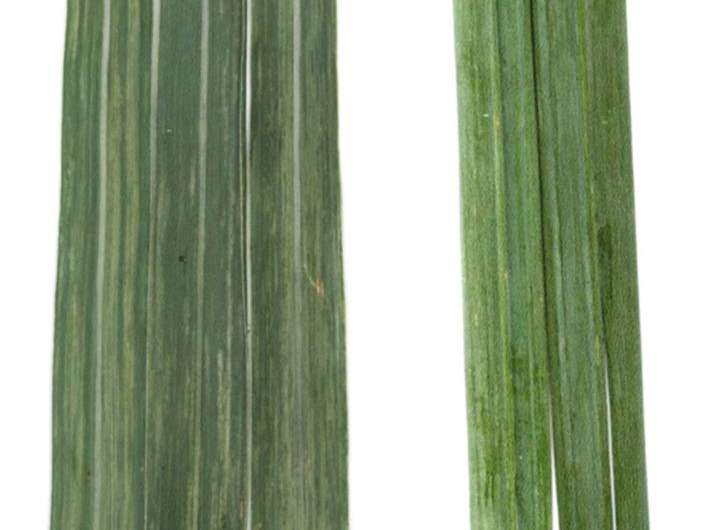First report of a new crop virus in North America

The switchgrass exhibited mosaic symptoms—splotchy, discolored leaves—characteristic of a viral infection, yet tested negative for known infections. Deep sequencing, a new technology, revealed the plants were infected with a new virus in the genus mastrevirus, the first of its kind found in North America.
University of Illinois scientists reported in Archives of Virology evidence of the new mastrevirus, tentatively named switchgrass mosaic-associated virus 1 (SgMaV-1). Other members of the mastrevirus genus, a group of DNA viruses, are known to be responsible for decimating yields in staple food crops (including corn, wheat and sugarcane) throughout Africa, Europe, Asia and Australia. It has never been reported in North America.
Many mastreviruses are transmitted from plant to plant by leafhoppers. The rate of infection rises with leafhopper populations, which can cause widespread epidemics and complete yield loss in some crops. Researchers are not sure what vector transmits SgMaV-1 and the impacts of the virus on switchgrass biomass yield, nor do they know what other crops the new virus affects.
"My fear is that this virus is in corn and wheat, and we are not even aware of it," said first author Bright Agindotan, a former postdoctoral researcher at the Energy Biosciences Institute, housed within the Carl R. Woese Institute for Genomic Biology. "It's like when you are sick and go to the hospital, but the doctors say nothing is wrong with you because they only test for what they know."
To be considered the same species in the mastrevirus genus, two viruses must share a minimum of 75 percent of the same genome. Agindotan and his team found two virus isolates that shared 88 percent of the same genome, but just 56-57 percent of any other known mastrevirus. These two isolates are strains of SgMaV-1.
Researchers tested 17 switchgrass varieties that had mosaic symptoms at the EBI Energy Farm. They detected the new virus in all but one variety, called Shenandoah. Switchgrass is a perennial crop, so these infected plants will continue to grow and accumulate the virus year after year, serving as a reservoir for the virus.
"We don't know the impact of this virus on the biomass yield of the energy crops," said Agindotan, who is currently a research assistant professor at Montana State University. "We don't know if this virus will affect cereal crops. We don't know the specific leafhoppers that transmit it, assuming it is transmitted by leafhoppers like other members of the mastrevirus genus."
The mosaic symptoms may have been caused by SgMaV-1, another type of virus infecting the plant, or some combination of the two. In future studies, virus-free plants will need to be infected with SgMaV-1 to see which species are vulnerable and what symptoms emerge. Additional research will determine infectivity, host range, pathogenicity, epidemiology, and vector transmission of SgMaV-1.
"The world is like a global village," Agindotan said. "Plants are imported into United States legally (and illegally) after being certified free of a list of restricted pests. The list is based on known pests. So, it is possible to import plants infected with unknown pests. The origin of the new virus is unknown, but it is most closely related to members of the mastrevirus genus found in Australia.
"You can only test for what you know. Using a technology that detects both known and unknown pathogens is a good tool for food safety and biosecurity," Bright concluded.
More information: The paper, "Detection and characterization of the first North American mastrevirus in switchgrass," is available online: DOI: 10.1007/s00705-015-2367-5
Provided by University of Illinois at Urbana-Champaign



















